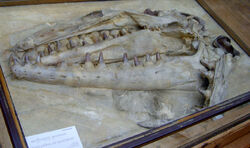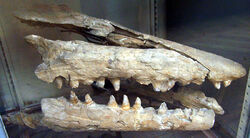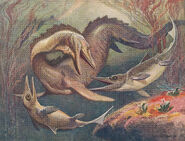| Mosasaurus Fossil range: Cretaceous | |
|---|---|
 Mosasaurus | |
| Scientific classification
| |
|
Mosasaurus | |
(nomen dubium)
| |
| |
Mosasaurus ("lizard of the Meuse River") was a genus of mosasaur, a carnivorous, aquatic lizard, somewhat resembling a flippered crocodile, with elongated heavy jaws. The genus lived in the Maastrichtian age of the Cretaceous period (Mesozoic era), around 70-65 millions years ago in the area of modern Western Europe. The genus Capelliniosuchus, once thought to be a metriorhynchid crocodylian, is a junior synonym of Mosasaurus.
History of discovery[]
Mosasaurus was the first genus of mosasaur to be named. The first remains known to science were a fragmentary skull from a chalk quarry in the St Pietersberg, a hill near Maastricht, The Netherlands, found in 1764 and collected by lieutenant Jean Baptiste Drouin in 1766. It was in 1790 described as a fish but not named, by Martinus van Marum, the first director of the Teylers Museum at Haarlem.[1] The same year Van Marum procured the fossil for the museum; it is still part of the collection as TM 7424.[2]
At some time between 1770 and 1774 (the often mentioned date of 1780 is incorrect) a second partial skull was discovered and procured by canon Theodorus Joannes Godding, who displayed it in his country house on the slope of the hill. A local retired German/Dutch army physician, Johann Leonard Hoffmann, also collected some fragments and published about the skull; his correspondence with international scientists made the find world famous. Hoffmann presumed the animal was a crocodile. In 1786 however, the Dutch Profesor Petrus Camper disagreed and concluded the remains were those of an unknown sperm whale, of a Physeteris incogniti ex Monte S. Petri.[3]
In 1794 Maastricht, an important fortress city, was captured by the French revolutionary armies. Accompanying the French troops was geologist Barthélemy Faujas de Saint-Fond on a mission to secure the piece, together with représentant du peuple (political commissar) Freicine who during the campaign tried to transport anything of artistic or scientific value he could lay his hands on to France. Finding that it had been removed from the cottage and hidden within the fortress, Freicine offered "six hundred bottles of good wine" to those troops being the first to locate the skull; soon a dozen grenadiers claimed their reward, carrying the piece with them. Early 1795 it was moved to Paris as war booty, by decree declared a national heritage and added to the collection of the new Muséum national d'Histoire naturelle.
In 1799 Faujas de Saint-Fond published his Histoire naturelle de la montagne de Saint-Pierre de Maestricht [Tome 2] which also contained an account of the circumstances of the find. According to him Dr Hoffmann paid the quarrymen extra to look out for especially large specimens. When the skull was found on 1770 Hoffmann would have been present during the excavation. Afterwards Godding would have claimed his rights as landowner and forced Hoffmann to relinquish his ownership through a lawsuit, won by influencing the court. De Saint-Fond would nevertheless in 1795, saving the specimen for science, have paid a considerable indemnity to Godding to compensate for his loss. However, as Dutch historian Peggy Rompen showed, of this famous story very little can be substantiated by other sources. Godding was the original owner, Hoffmann clearly never possessed the fossil, there was no lawsuit, de Saint-Fond probably never paid anything and the entire account seems to have been fabricated by him to justify the dispossession by military force.[4]
De Saint-Fond still assumed the specimen represented a crocodile. In 1798 the son of Petrus Camper, Adriaan Gilles Camper, again studied the fossil indirectly by reconsidering the description by his father. He was the first to reach the conclusion that the remains were those of a giant monitor, which result in 1799 he corresponded to Georges Cuvier.[5]
In 1808 Cuvier confirmed Camper's result. The fossil had already become part of Cuvier's first speculations on the possibility of animal species going extinct. The idea of extinction paved the way for his theory of catastrophism or "consecutive creations", one of the predecessors of the evolution theory.
A scientific name had not yet been given to the new species, the specimen usually being referred to as the Grand Animal fossile des Carrières de Maëstricht or "Great Fossil Animal of the Maastricht quarries". In 1822 William Daniel Conybeare named it Mosasaurus after the Latin name (Mosa) of the Maas (Meuse) River passing through Maastricht, the second skull being the holotype, MNHNP AC9648. The specific name (epithet) hoffmannii was added by G.A. Mantell in 1829, honouring surgeon C.K. Hoffmann, on the presumption he was the discoverer of the type specimen. Today the emendated form hoffmanni is most often used.
In 1854 German biologist Hermann Schlegel was the first to conjecture Mosasaurus had flippers instead of normal feet.
In 1998, another, even bigger and more intact fossil skull was found in the Maastricht limestone quarries, nicknamed "Bèr", and displayed in the Maastricht Natural History Museum. However, it was determined this find represented a new species of the genus Prognathodon.
Evolution[]
As with most mosasaurs, their legs and feet are modified into hydrofoil-like flippers, with the forelimbs larger than the hindlimbs. The first mosasaur ever discovered, Mosasaurus hoffmannii, was excavated in a mine near Maastricht, the Netherlands in the 1770s. Like its American relatives Tylosaurus and Hainosaurus, Mosasaurus reached lengths of about 15 meters. However, Mosasaurus was much more robust than tylosaurine mosasaurs, at some double the weight of a mosasaur of the same length. In life, a 10 m long Mosasaurus was as heavy as a 15 m long Tylosaurus.
Anatomy[]

Mosasaurus hoffmannii jaw fragments, Muséum national d'histoire naturelle, Paris.

Mosasaurus gaudryi jaw fragments, Muséum national d'histoire naturelle, Paris.
Mosasaurus was among the last mosasaur genera, and among the largest. The skull was more robustly built than other mosasaurs, as the mandibles articulated very tightly with the skull. It had a deep, barrel-shaped body, and with its fairly large eyes, poor binocular vision, and poorly developed olfactory bulbs, experts believe that Mosasaurus lived near the ocean surface, where it preyed on fish, turtles, ammonites, and possibly smaller mosasaurs. The animal remained near the surface and although it was able to dive, it most likely did not venture into deeper waters.
The skull of Mosasaurus tapered off into a short, conical process, and the jaws were armed with massive, sharp, conical teeth. Their paddle-like limbs had five digits in front and four in back. The trunk terminated in a strong tail which, together with serpentine undulation of the whole body, contributed far more to the animal's locomotion that did the limbs.
Because of its robust skull and tightly articulating jaws, Mosasaurus was unable to swallow prey-items whole in the manner of earlier mosasaurs, such as Tylosaurus. Instead, with the aid of its curved, knife-like teeth, Mosasaurus was able to tear its prey into more manageable pieces that could be more easily swallowed.
As mentioned before, Mosasaurus was discovered near the town of Maastricht, located at the southernmost tip of the Netherlands. The city is largely built with blocks of limestone from the town's quarry. In 1770, the local Dutch army physician, Dr Hoffmann, who had developed an interest in the strange bones that kept showing up in these blocks of limestone, paid the quarrymen extra to look out for especially large specimens. The best of these was found in 1774, and it was named Mosasaurus hoffmannii. It was a very controversial find, as the skull belonged clearly to a species that no longer existed on earth, and it raised the first speculations on the possibility of animal species going extinct. The idea of extinction paved the way for the theory of "several creations", one of the predecessors of the evolution theory. A few years after the find, the French armies occupied Maastricht and the fossil skull was taken to Paris, where it is was studied by G. Cuvier. The skull still on display in the Muséum National d'Histoire Naturelle.
In 1998, another, even bigger and more intact fossil Mosasaurus skull was found in the Maastricht limestone quarries. It was nicknamed "Ber" and it is currently on display in the Maastricht Natural History Museum.
Relatives[]
The family Mosasauridae is split into several subfamilies, with Mosasaurus being placed within Mosasaurinae. This subfamily, in turn, is further split into smaller tribes, with Mosasaurus being grouped with Clidastes, Moanasaurus, Amphekepubis, and Liodon in the tribe Mosasaurini.
Gallery[]
Notes[]
- ^ M. van Marum, ‘Beschrijving der beenderen van den kop van eenen visch,…’, Verhandelingen Teylers Tweede Genootschap 9 (1790), p. 383-389
- ^ Mulder, Eric Wolfgang Amadeus. 2004. "Maastricht Cretaceous finds and Dutch pioneers in vertebrate palaeontology". In: Touret, J.L.R. & Visser, R.P.W. (eds). Dutch pioneers of the earth sciences, pp. 165-176. Royal Netherlands Academy of Arts and Sciences (KNAW), Amsterdam
- ^ P. Camper, "Conjectures relative to the petrifactions found in St. Peter’s Mountain near Maestricht", Philosophical Transactions, 76: 443-456
- ^ P. Rompen, 1995, Mosasaurus hoffmanni: De lotgevallen van een type-exemplaar
- ^ A.G. Camper, 1800, "Lettre de A.G. Camper à G. Cuvier sur les ossemens fossiles de la montagne de St. Pierre, à Maëstricht", Journal de Physique 51 (1800) p. 278-291
References[]
- Bardet, N. and Jagt, J.W.M. 1996. Mosasaurus hoffmanni, le “Grand Animal fossile des Carrières de Maestricht”: deux siècles d’histoire. Bulletin du Muséum national d’Histoire naturelle Paris (4) 18 (C4): 569–593.
- Benes, Josef. Prehistoric Animals and Plants. Pg. 144. Artia, 1979
- Mulder, E.W.A. 1999. Transatlantic latest Cretaceous mosasaurs (Reptilia, Lacertilia) from the Maastrichtian type area and New Jersey. Geologie en Mijnbouw 78: 281–300.





